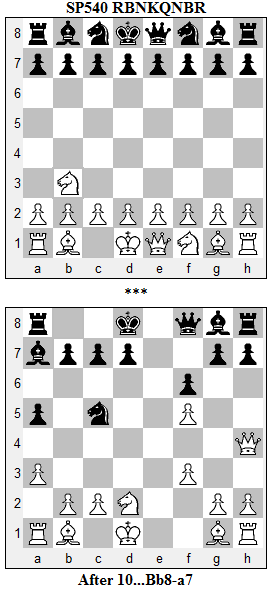The flagship chess960 event at Mainz that year, billed as the Chess960 World Championship, was a double round robin featuring four world-class chess grandmasters. The two players with the best scores in the preliminary event then played a four game match to determine the Chess960 World Champion. Each round played at Mainz uses the same start position (SP) on all boards, and the fourth round of the preliminary event saw RBNKQNBR (SP540) in both games.
The pairings for that round were Aronian - Nakamura and Bologan - Movsesian. Aronian had finished the first three rounds with a perfect score of 3.0, while the other players were tied at 1.0 each. To stay in the running for the title match Nakamura needed at least a draw in this second game against Aronian.
The start position is shown in the following diagram, along with Aronian's first move, 1.Nb3. The position resembles the traditional start position RNBQKBNR (SP518), but the placement of the minor pieces makes a big difference. A Bishop starting the game on the b- or g-file is not particularly well placed and here both players have two such Bishops. What's the best way to develop them?
Nakamura solved the problem for his dark-squared Bishop with the bizarre 1...a5, planning to bring it out via a7. At the same time he made space for the Rook and prepared a possible ...a4, harrassing the Knight. The downside of the move is that it neglects the center and renounces castling O-O-O. It's worth noting that the other game, Bologan - Movsesian, saw the same idea a few moves later: 1.e4 e5 2.f3 f6 3.Nb3 a5.

The second diagram shows the position after ten moves by both players. Aronian has also decided to develop his Queenside (a-side) Bishop via the short diagonal, while both players have chosen to develop the other Bishop on its long diagonal. How to assess the position? Black has a Queenside majority, while White's Kingside (h-side) majority is crippled, giving Black a slight, long-term positional plus.
The game continued 11.Bf2 Qd6 12.Qg3 Qxg3 13.hxg3, swapping Queens, when Black went after the b-Pawn with 13...Na4 14.Bxa7 Rxa7. White could have defended the Pawn with 15.Kc1, or even 15.Rh4, but played speculatively with 15.Ba2, and never managed to recover the lost Pawn. Here is the PGN of that game, courtesy of Chess Tigers.
[Event "CCM9 - Chess960 Rapid WCh"]
[Site "Mainz"]
[Date "2009.07.29"]
[Round "4.1"]
[White "Aronian, Levon"]
[Black "Nakamura, Hikaru"]
[Result "0-1"]
[Variant "chess 960"]
[SetUp "1"]
[FEN "rbnkqnbr/pppppppp/8/8/8/8/PPPPPPPP/RBNKQNBR w KQkq - 0 1"]
1.Nb3 a5 2.e4 e5 3.d4 exd4 4.f3 Ne6 5.Nxd4 Nd6 6.Nf5 Qf8 7.Nd2 f6 8.a3 Nxf5 9.exf5 Nc5 10.Qh4 Ba7 11.Bf2 Qd6 12.Qg3 Qxg3 13.hxg3 Na4 14.Bxa7 Rxa7 15.Ba2 Nxb2+ 16.Kc1 Bxa2 17.Kxb2 Bf7 18.Rae1 h6 19.Re4 b5 20.Rg4 Rg8 21.Nb3 a4 22.Nc5 d6 23.Rd1 h5 24.Re4 Re8 25.Ne6+ Bxe6 26.fxe6 g6 27.g4 hxg4 28.fxg4 Ra6 29.g5 f5 30.Re2 Rc6 31.Rde1 Rc4 32.g3 Rg4 33.Re3 c6 34.e7+ Kd7 35.Re6 Rxg5 36.Rf6 Rxe7 37.Rd1 d5 38.Rh1 Rh5 39.Rxh5 gxh5 40.Rxf5 Rg7 41.Rxh5 Rxg3 42.Rh6 Kc7 43.Rh8 Kb6 44.Rh6 Kc5 45.Rf6 Re3 46.Rh6 d4 47.Rh5+ Kc4 48.Rh6 c5 49.Rh4 b4 50.axb4 Kxb4 51.Rh5 c4 52.Rh1 a3+ 53.Kb1 0-1
Nakamura won all three games in the second leg of the event, matched Aronian's final score, and the two players squared off the next day for the title. For an overview of the entire event, including links to external resources, see CCM9: Nakamura, Grischuk, and Rybka.

1 comment:
Concerning switching pieces in the standard array, please have a look at Relocation variants. Especially my suggestion of "Fischer Placement Chess" is relevant to this blog.
Mats
Post a Comment